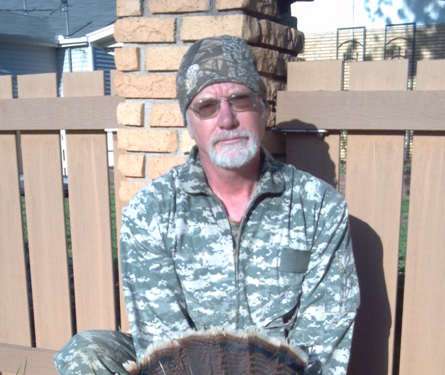I didn’t hunt spring turkeys last year because I had just had my left knee replaced (I know, excuses, excuses!) And even though calling-in a Kansas wild turkey is easily in my top ten experiences ever, I find myself making excuses, again, not to go (I’m too unsteady on my feet these days, its cold, blah, blah, blah!) But whether I ever hunt spring turkeys again, I’ll never forget harvesting my first Kansas spring turkey several years ago.
The evening was hot and steamy, but as I remember, it was also the first windless night we had been given for awhile. I had nearly a quarter of a mile to walk, but thankfully it was an easy walk through a closely-cropped pasture. I had not hunted here before, but the landowner’s wife had described my destination as being a windmill surrounded by a corral, just out of sight from where I parked. After working an eight-hour day, and because of the heat, there was not much spring in my step as I trudged to along lugging my blind, a duffle bag containing decoys and a small camp chair plus my shotgun. Ten days remained, but because of upcoming vacation and other commitments, spring turkey season for me was nearly over. I also remember thinking I needed to adjust my priorities. The landowner passed me in his pickup, heading toward the windmill to turn off the water. On his return trip, he told me he had spooked five turkeys that were already in the corral rooting around for an evening snack. My steps grew a little more determined, figuring they would be back for the easy pickings around the feed bunks.
Our hunting blind works great, but being a camouflaged pattern, it works best when set up under or around trees or brush of some sort; there, however, my choices were limited. The best camouflage for the blind was either across a fence or not where I predicted the turkeys to appear. A spot caught my eye, and the blind was soon tucked in beside a cattle chute and a salt feeder, which sat just outside the corral opening, counting on those structures rather than foliage for camouflage. The decoys were set up at an angle in front of the blind to draw any turkeys past me for a shot. A slight breeze was welcomed as I settled into the blind and called a couple of times to attract the attention of any nearby toms.
My wait was short, as a hen appeared and began cleaning up after the cattle around the several feed bunks. She was less than forty yards away and seemed oblivious to me and the blind. “This is good,” I told myself, and my confidence grew. A tom soon appeared as if from nowhere as they often do, and began to follow the hen around the bunks. I “clucked” softly to him with the call, hoping to interest him in a little romance with the plastic “floozy” staked in front of me. As he ambled in her direction, his gait told me it was out of curiosity, and not for love. He circled the decoys, but I sensed the plastic “darling” had not done her job, and his pace quickened as he headed back toward the real hen. Although quite suspicious of the entire scene, he paused slightly to look in my direction; just the break I needed and my first Kansas turkey lay in the grass before me. He was probably a two- or three-year-old with an eight-inch beard, worn thin from breeding, and razor sharp one-inch spikes. His back feathers glistened with shades of blues and greens in the evening sun. He made me proud to be a Kansas Wild Turkey hunter!
I have shot turkeys from some peculiar places, even from 15 feet high in a deer tree stand. The irony in all this stems from the fact that I harvested my first Kansas whitetail deer from a cattle coral on Joyce’s uncle’s ranch, and now I’d just taken my first Kansas wild turkey from a cattle coral also. My wife’s first words when I walked in the door were “What is it with you and corrals!” I really don’t know, and I really don’t care, just don’t expect me to start hunting with a lasso just so I can continue to Explore Kansas Outdoors!
Steve can be contacted by email at stevenrgilliland@gmail.com.





